
Demystifying Advanced Persistent Threats (APT): Anatomy, Prevention, and Detection
Welcome to the Secure Debug blog, where we dive deep into the world of cybersecurity. In this post, we will unravel the enigma surrounding Advanced Persistent Threats (APT), exploring their anatomy, prevention strategies, and detection techniques. APTs represent one of the most dangerous and sophisticated cyber threats in existence, making it crucial for organizations to understand and defend against them.
Anatomy of Advanced Persistent Threats (APT)
Before delving into prevention and detection, let’s understand the anatomy of APTs. An APT is a prolonged cyber attack carried out by highly skilled and motivated threat actors. Unlike traditional attacks, APTs are stealthy, persistent, and often remain undetected for extended periods, allowing adversaries to achieve their objectives.
APTs typically involve several stages:
- Reconnaissance: Adversaries conduct extensive research to gather information about the target organization, its infrastructure, and employees.
- Initial Compromise: Using various techniques like phishing, watering hole attacks, or exploiting vulnerabilities, the attackers gain an initial foothold within the target’s network.
- Establishment of Persistence: Once inside the network, the attackers establish a persistent presence by deploying backdoors, creating hidden user accounts, or modifying system configurations.
- Lateral Movement: APT actors explore the compromised network, moving laterally to gain access to valuable assets, escalate privileges, and gather sensitive data.
- Exfiltration: Finally, the attackers exfiltrate the stolen data or achieve their intended objectives, which could range from espionage to sabotage.
Preventing APT Attacks
Effective prevention measures can significantly reduce the risk of falling victim to APTs. Here are some key strategies:
- Employee Education and Awareness: Human error is often the weakest link. Regularly train employees to recognize and report suspicious activities, such as phishing emails or social engineering attempts.
- Strong Access Controls: Implement multi-factor authentication, strong password policies, and the principle of least privilege to restrict unauthorized access.
- Regular Patching and Updates: Keep all software and systems up to date with the latest security patches to mitigate known vulnerabilities.
- Network Segmentation: Divide your network into segments, ensuring that critical assets are isolated and access is strictly controlled.
- Endpoint Protection: Deploy advanced endpoint security solutions that incorporate antivirus, anti-malware, and behavior-based detection mechanisms.
Detecting Advanced Persistent Threats (APT)
While prevention is crucial, organizations must also focus on timely detection to minimize the impact of APT attacks. Here are some key detection techniques:
- Threat Intelligence: Leverage threat intelligence feeds to stay updated on the latest APT campaigns, indicators of compromise, and emerging attack techniques.
- Network Monitoring: Implement robust network monitoring solutions that can detect anomalous activities, unusual traffic patterns, or suspicious behavior within the network.
- Behavioral Analytics: Utilize advanced analytics tools to establish baselines of normal behavior and identify deviations that may indicate an ongoing APT attack.
- Endpoint Detection and Response (EDR): Deploy EDR solutions to monitor endpoint activities, detect malicious processes, and quickly respond to potential APT incidents.
- Threat Hunting: Proactively search for signs of APTs by conducting in-depth investigations, analyzing logs, and using advanced forensic techniques.
By implementing a robust prevention strategy and investing in effective detection mechanisms, organizations can fortify their defenses against APTs and minimize the potential damage caused by these persistent adversaries.
Stay Connected with Secure Debug
Need expert advice or support from Secure Debug’s cybersecurity consulting and services? We’re here to help. For inquiries, assistance, or to learn more about our offerings, please visit our Contact Us page. Your security is our priority.
Join our professional network on LinkedIn to stay updated with the latest news, insights, and updates from Secure Debug. Follow us here.







